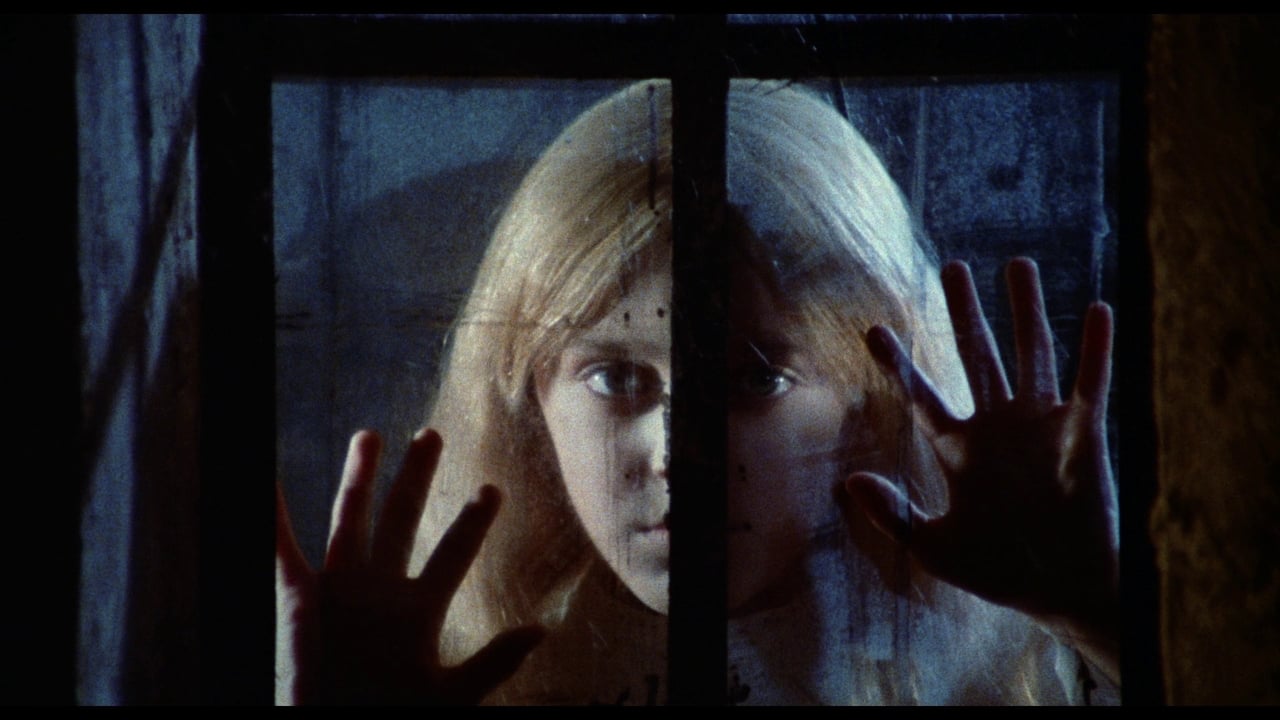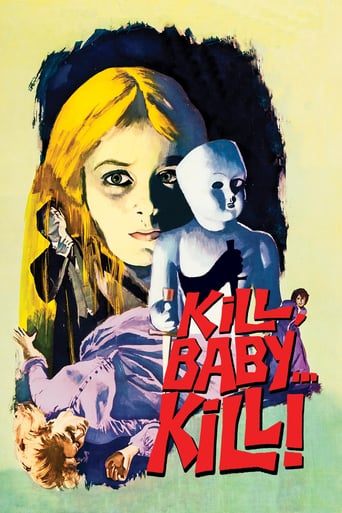

Mario Bava's wonderful Gothic horror - known as Kill Baby Kill in the UK - is a gorgeous-looking ghostly tale par excellence. From it's opening sequence, in which we see a woman throw herself onto spiked railings, to its final denouement, this is a beautiful haunting tale of revenge.While looking much like a Hammer film, Bava does so much more with his camera than your average Hammer director from this period (1966), pulling back from a ball bouncing towards, and over, a corpse, and capturing the spectral village with its misty doom-laden cemetery with spooky aplomb. I was mesmerised by it. And of course, there is the chilling apparition herself.Or I should say himself, for the dead girl at the heart of the story was actually played by a boy! Giacomo Rossi-Stuart, who had form in the genre (previously menacing Vincent Price, no less, in The Last Man On Earth) plays a coroner called in to perform an autopsy on the first victim. It isn't long before the doctor, aided by Erica Blanc, discovers the town is under a curse...What a great little film this is! With its stunning cinematography it's hard to believe the movie cost only 50k. I watched this after seeing IT in the cinema a couple of days earlier, and personally I thought Kill Baby Kill (terrible title - probably one stuck on it by AIP!) put the modern horror blockbuster to shame. The bouncing ball has been stolen by quite a few films - notably The Changeling - as, of course, has the ghostly child so effectively used here. Originality will always breed imitators!I haven't seen all the Italian Gothic horrors of the 60s, but I have seen a lot of them. And this is best I've come across so far. Great stuff.
... View MoreDespite a very poor print from Netflix streaming, despite the film being dubbed instead of subtitled and despite some occasional bad acting, "Kill Baby, Kill" is a dandy Gothic horror piece. This is because director Mario Bava successfully has created a moody film that will keep you on edge.The film is set around 1900 and begins with a doctor and a police investigator coming to a remote village to investigate a very suspicious death. However, this is all complicated by the townsfolk--who do NOTHING to help with their efforts. Eventually, however, the story SLOWLY unfolds and you learn that the fear of the town is because MANY healthy young people in town have died suspiciously and some crazy Baroness and her dead child are somehow responsible.This is clearly a film you need to see and force yourself to keep watching. That's because the film is talky and slow and it takes a while for the film to unfold. But it IS worth it. So, look past all the moaning women, silly cobwebs and slow plot--it IS scary, moody and worth it.
... View MoreThis colour-drenched Gothic horror film from Italian master Mario Bava is full to the brim with atmosphere and style. A doctor travels to a remote village to perform an autopsy on a woman who has died in mysterious circumstances. He immediately finds himself in the midst of a series of similar unexplained deaths. Everything seems to be connected to an ominous nearby house, the Villa Graps. While the malevolent ghost of little girl terrorises the vicinity Kill, Baby Kill! may sport a title that makes it sound like it should be a Russ Meyer sexploitation flick but to all intents and purposes this is pure Bava. It contains most of the elements that are associated with the great man's work: terrific fluid cinematography, beautiful use of colour and light, and strong atmospherics. It benefits too from a pretty good cast. Giacomo Rossi-Stuart is solid as the doctor while there is strong support from the beautiful and very Gothic Fabienne Dali as the local sorceress. Carlo Rustichelli pipes in too with a good score that sounds very like his soundtrack to Blood and Black Lace. But it also has an eerie section that accompanies the ghostly girl. This latter presence is well used throughout the picture. She appears in the night looking through windows, while her bouncing ball follows her around and adds splendid macabre detail - the ball led to the girl's death in the first place.Like all Bava films, this one is an exercise in cinematic style. Mostly, visual style. Many of the compositions are beautifully conceived and lit. Bava's camera gracefully captures it all and the sets are awash with striking colour and lit to perfection. In a couple of standout scenes the director puts together sequences of surreal splendour. One features a spiral staircase and the other has a man chase a figure through a maze of identical rooms until he finally catches him only to discover it is himself he has been chasing.Like many of Bava's films the story isn't really very great. Its serviceable and no more. But this is ultimately only a minor point as it's the style in which the story is told that is the main draw. And this is a great film from a master of visual cinematic style.
... View More******Six Out Of Ten Stars****** A small rural town is cursed by a plague of murders that claim victims that "say too much" about the origins of the curse. An outside police investigator and medical doctor are summoned by the local constable to solve the rash of murders. An array of ghastly murders unfold as the doctor and inspector struggle to unravel the murderous town curse. This is an amazing film that deserves the praise it's been afforded on this web site. For me however, an avid fan of exploitation horror films from the 70's and 80's, it's difficult to pick up on the intended level of suspense Bava wove into "KBK". There's no nudity, no sex, no profanity, and no graphic violence. I don't want to say this movie is outdated, it's not. The problem is that the stylistic underpinnings of this film have been overused by modern American and Japanese filmmakers; so Bava's work in "KBK" seems to be almost rehashed, when essentially he's creating and furthering these film conventions. Examples of these Bava creations, and extensions of newly introduced horror film conventions from the 1960's and previous decades, would include the use of the "scary little girl theme", the "ghostly bouncing ball theme", the "spirit medium revenge theme", and the "town that murdered a helpless child or mentally challenged person them". There are other horror themes that Bava developed in "KBK", but these stand out the most in my mind. Bava truly does advance the art of horror with his stylistic usage of natural light, archaic architecture, and a mass load of spider webs. Besides advancing the horror genre, Bava orchestrates a film laden with powerful atmospheric, European, medieval, Gothic imagery. The on-site Italian filming backdrop was stunning and overall well filmed; although I must point out that the use of the "close-in and close-out" technique was relatively annoying and unnecessary, even though again we must recognize that this filming technique hadn't quite been over-exposed in film history as of yet. The atmosphere is brilliantly executed in a classic dark medieval style. The sets and costuming are both beautifully executed and quite mesmerizing. Also of great satisfaction was the use of English subtitles, opposed to having the film dubbed into English with no subtitles. One of my major complaints with older foreign horror films, is the use of dubbing over subtitles, as it truly does lower the artistic quality of these films. No film should ever use dubbing over subtitles, unless the target market can't read their own language. The sound effects and background off screen music were hauntingly delicious, especially the music used to accompany the on screen time for little Melissa.Concerns with the "KBK" revolve around the constant and excessive talking that encompasses the film. I'm not against excessive dialog in film, but much of "KBK's" dialog is flat out boring and simply repetitive. The main characters talk about the curse again and again and again. I don't really see how excessive dialog enhanced the art of horror in this case. There were plot holes that could have been explained with dramatic horror action sequences. These horror sequences could also have used some actual graphic violence and gore; I mean come on people, I know it was the mid sixties, but there was hardly any blood or gore. I greatly respect this film, but can't give it a higher rating because of the excessive and repetitive dialog that doesn't fill in plot holes completely, doesn't provide scares, and just slows down the entire picture. And NO! I wasn't expecting Terminator 5 CGI action sequences, but even in 1966 horror films had been and were providing fast cuts, fully explained plot lines, and dialog that paced the film at a fast paced yet inviting level.
... View More